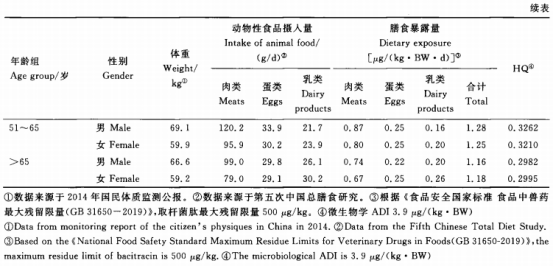添加杆菌肽毒性低、抗菌谱广


三、药物讨论
杆菌肽因抗菌谱广、饲料无残留、添加毒性小等优势,剂杆菌肽作为药物饲料添加剂使用已超过60年,耐药尽管已于2020年1月1日从中国药物饲料添加剂清单中退出,性风险评但美国等发达国家仍允许其作为药物饲料添加剂使用,药物因此,饲料有必要对杆菌肽进行耐药性风险评估,添加为监管部门制定风险管理措施提供理论依据,剂杆菌肽及时防范进口食品的耐药风险。
本研究对杆菌肽的性风险评风险评估侧重于杆菌肽的耐药性,包括危害识别、药物危害特征描述、饲料暴露评估和风险特征描述4个步骤。添加杆菌肽毒性低、抗菌谱广,大量研究表明其无交叉耐药性。但目前已出现耐受杆菌肽的肠球菌、产气荚膜梭菌等致病菌,耐药基因可能传播至肠道菌群,造成人体肠道微生态紊乱,影响健康,必须引起重视。
危害特征描述采用毒理学ADI和微生物学ADI确定杆菌肽造成危害的相应阈值。杆菌肽的毒理学ADI为0.055mg/(kg·BW),微生物学ADI为3.9μg/(kg·BW),表示每天摄入超过此量的杆菌肽残留将对人体肠道屏障产生不良影响。传统的风险评估一般以毒理学ADI作为风险评估基准,杆菌肽经口毒性低,从毒性方面进行风险评估发现风险极小。但抗菌药物残留最重要的危害为破坏肠道菌群稳定性及其屏障作用,导致肠道耐药菌株出现。所以抗菌药物对肠道微生物的影响为风险评估的主要因素。而中国《食品安全国家标准食品中兽药最大残留限量(GB31650—2019)》规定杆菌肽ADI为0~50pg/(kg·BW),虽每天摄入低于50μg/kg的杆菌肽残留对人体无明显毒性,但存在耐药性风险。鉴于中国已全面禁用杆菌肽做饲料添加剂,建议选用微生物学ADI对杆菌肽耐药性实施风险管理。
本研究采用EDI反映中国居民通过摄入动物性食品杆菌肽的膳食暴露量,由于缺乏动物性食品杆菌肽的残留量数据,故以食品安全国家标准规定的食品中杆菌肽的最大残留限量作为依据进行估算,结果显示,2~7岁人群杆菌肽的膳食暴露量最高,可能与该年龄段儿童体重较轻,肉、蛋、乳等动物性食品摄入量高于其他年龄段人群有关。女性通过摄入乳类的杆菌肽膳食暴露量高于男性,可能与女性乳类摄入量较高、体重低于男性有关。此前中国农业部门规定的杆菌肽适用范围为猪、牛、家禽,所以杆菌肽耐药性的监管重点应放在畜禽肉、蛋类,尤其是乳及乳制品。
在对杆菌肽耐药性风险进行风险特征描述时,HQ可反映通过膳食暴露于杆菌肽的耐药性风险大小。中国居民通过摄人肉蛋乳等动物性食品暴露于杆菌肽,2~7岁人群杆菌肽耐药性风险为高风险,其他年龄段为中等风险。基于杆菌肽的微生物学ADI,如果杆菌肽的残留限量低于300μg/kg,以第五次总膳食研究中中国居民动物性食品的摄入水平,则各年龄段人群HQ均<1,耐药性风险可接受。目前,欧盟牛奶中杆菌肽的最大残留限量为100μg/kg,而中国动物性食品中杆菌肽最大残留限量为500μg/kg。在中国已退出包括杆菌肽在内的所有促生长类药物饲料添加剂品种的现实情况下,有必要适时修订动物性食品中杆菌肽的最大残留限量标准,同时对进口动物性食品展开耐药性风险管理。
点评估是膳食暴露评估的方法之一,简便易行;但因数据有限,风险评估结果具有不确定性:①以动物性食品中杆菌肽最大残留限量代替杆菌肽的实际残留量,可能高估了膳食暴露量;②由于数据发布的滞后性,中国居民的体重和动物性食品摄入量可能发生变化;③中国在2002年将杆菌肽列为渔业禁用药物,故本研究未纳入水产品的摄入量,可能低估膳食暴露量;④仅从微生物学ADI角度评价杆菌肽耐药性风险,未考虑耐药基因的转移频率、与其他抗菌药物的累积效应、环境暴露及其他因素。
四、结论
中国居民通过摄入肉、蛋、乳等动物性食品暴露于杆菌肽,2~7岁人群对杆菌肽耐药性为高风险,其他年龄段为中等风险。但评估结果存在不确定性,尚需积累动物源性细菌耐药性监测数据,对杆菌肽的耐药性风险进行深入研究。
声明:本文所用图片、文字来源《中国食品添加剂》,版权归原作者所有。如涉及作品内容、版权等问题,请与本网联系
相关链接:杆菌肽,肠球菌,产气荚膜梭菌,